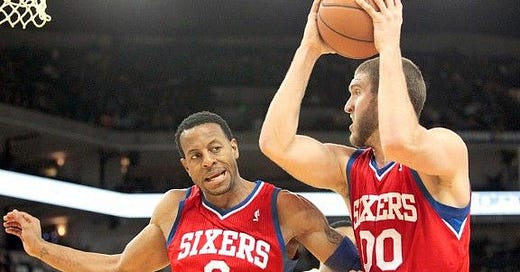The 76ers' Winning Blueprint
You might not have noticed it, but the 2012 Philadelphia 76ers are quietly having one of the greatest defensive seasons of all time. They currently lead the league with the fewest points allowed per game (88.2) and, more importantly, per 100 possessions (98.0). If they can hold off Boston in the latter category for another three weeks, they'll have accomplished a feat only nine teams since 1986 can claim -- leading the NBA in defensive efficiency wire-to-wire.
Moreover, their defensive rating of 98.0 is the lowest any team has posted in the last eight seasons. Although the league as a whole has declined in points per possession during this lockout-shortened season, Philly's D has been historically great in terms of efficiency allowed relative to the league average. Using a simple method of estimating pace factor for teams prior to 1974, we determined that the 2012 Sixers rank 22nd among the best defensive NBA teams since 1951.
With that level of dominance on D, these Sixers have more than offset their 17th-ranked offense to place among the league's top five in schedule-adjusted PPG differential (one of the best predictors of playoff success).
How have they been able to craft such a dominating D? The key to Philadelphia's defensive prowess has been its ability to force missed shots then corral the rebounds. It currently allows the NBA's second-lowest effective field goal percentage (effective field goal percentage -- eFG -- a shooting stat that adjusts for 3-pointers being worth 1.5 times as many points as 2-pointers), and it has the league's third-best defensive rebounding rate.
Coach Doug Collins' strategy on defense has been clear: Protect the paint and force opponents to shoot midrange jumpers, the lowest-efficiency shots in the game. According to Hoopdata, Philly is currently allowing the league's third-lowest percentage of shot attempts (26.6 percent) from the immediate basket area. In concert with that number, they're also allowing the league's highest rate of field goal attempts from 10-to-23 feet, where the Sixers' opponents are making just 35.1 percent of their shots.
This is a powerful defensive game plan. During the 2012 season, the only opposing shot distance that is a significant predictor of defensive efficiency is the percentage of shots allowed from 10-to-23 feet. For every increase in 1 percent of opposing shots taken from that range, defensive efficiency improves by 0.6 points per 100 possessions. That may not sound like much, but just by forcing opponents to take 39 percent of their shots from that distance, Philadelphia has shaved 3.2 points off of its defensive rating relative to the league average -- the difference between being the 22nd-best defense of all time and merely being the league's seventh-best D this season.
Of course, with all those forced misses, it's also important to have guys who can crash the boards. While the Sixers don't possess any individually dominant defensive rebounders (their leading qualified player by defensive rebounding percentage is swingman Evan Turner, who ranks 18th in the league), they do have a plethora of players who are very good on the defensive glass. Along with Denver, Philadelphia boasts a league-leading six players on its roster who have played 450 or more minutes with a defensive rebound rate of 16.5 percent or better.
In addition to bigs such as Spencer Hawes, that number also includes Turner and Andre Iguodala -- arguably the two best defensive rebounding wings in the game (they rank 1-2 in defensive rebounding percentage among guards or guard/forwards). For Philadelphia, rebounding is truly a team effort, the essential second part of its two-pronged defensive philosophy.
That philosophy is a necessary one, given Philly's personnel. Although Iguodala and Jrue Holiday are experts at stealing the ball, the Sixers as a whole do not force turnovers well. Only 15.7 percent of Philadelphia's opposing possessions have resulted in giveaways, the 13th-lowest rate in the league, and according to a Four Factors-based plus/minus regression, only Iguodala and Thaddeus Young have any kind of significant positive impact on opponents' turnover rates. If the Sixers maintain their No. 1 defensive ranking, the 76ers will be one of 12 teams since 1974 to lead the NBA in defensive efficiency despite ranking among the league's bottom half in opposing turnover percentage.
It is to Collins' credit that he recognized his roster's shortcomings in that area and tailored his defense to be effective in a way that accentuates his players' strengths. Although the Sixers are hardly bereft of raw defensive talent -- Iguodala is the seventh-best defensive player in basketball by regularized plus/minus, and as Tom Haberstroh wrote Friday, Brand also has a strong defensive player of the year case -- the biggest driving force behind Philly's remarkable defensive year has been a core strategy that everyone on the roster seems to embrace.
It's a philosophy that sounds simple on paper but is incredibly difficult to execute on the hardwood. And when a team does it right, like the 2012 Sixers have, it can lead to historically great results.
Filed under: NBA, Classic Posts





